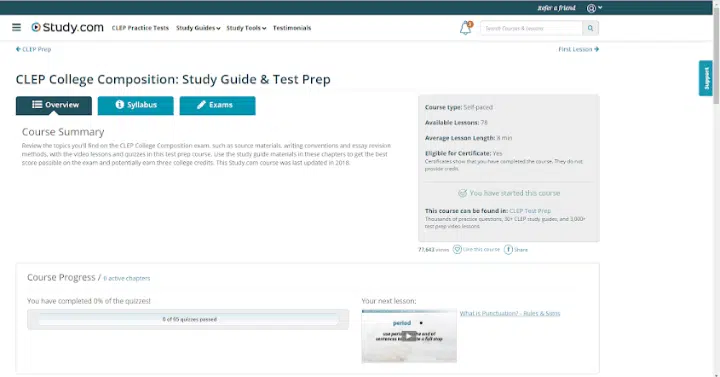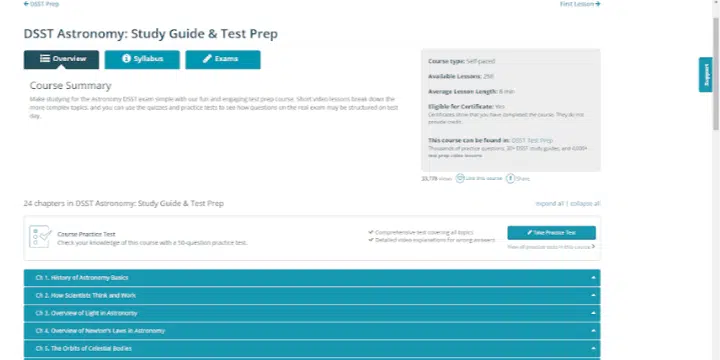How to Save Time and Money with CLEP and DSST Exams
Credit by exam allows homeschoolers to earn college credit in high school. Learn how to prepare with CLEP practice tests and DSST practice tests.
When researching online, Study.com frequently tops my search results. I love their concise, easy-to-understand articles, but I never realized that those search engine results were just the tip of the iceberg.
Study.com offers thousands of self-paced video courses to help students improve their grades and earn college credit online. It’s also ideal for adult learners like me who want to broaden their knowledge base.
One of the hidden gems on Study.com is their credit by exam test prep selection. They offer both CLEP study guides and DSST study guides included with site membership.
(They even have a complete homeschool program for grades 3-12!)

What Is Credit by Exam?
Credit by exam options were created to allow adult learners and military personnel to earn college credit based on life and work experience. A passing test score demonstrated college-level understanding and earned credit for that subject. Now, anyone can take a CLEP or DSST exam to earn college credit, including homeschooled students.
The College Board, the organization that develops and administers the SAT and PSAT, also designs CLEP (College Level Examination Program) exams. CLEP offers 33 tests in five subject areas. Over 2900 colleges and universities accept CLEP credit. Test-takers must complete the CLEP exam in 90 minutes.

DSST (DANTES Subject Standardized Tests) began as an academic testing option for military personnel. Today, it is owned and administered by Prometric, a U.S. test administration company. DSST offers 30 exams in six subject areas. Over 1900 schools accept DSST credit. Students must complete a DSST exam in 2 hours.
Both exams are approved by the American Council on Education. Students can take the tests at an official testing center, which is usually a college campus.
Each CLEP exam consists of 100 multiple choice questions with five options each. DSST exams include 100 multiple choice questions with four options each. Neither text has a writing portion, making them a good option for students with learning challenges such as dysgraphia.
Benefits of CLEP and DSST for Homeschoolers
There are many benefits to using CLEP and DSST exams for homeschooling students. First, you can list the study time for each test as dual-enrollment credit on your teen’s high school transcript. That means your student can work through study guides for exams and earn high school credit. Then, when he passes the exam, he earns college credit.
CLEP and DSST exams are a wise choice even for students who may not plan to attend college. Teens still earn high school transcript credit for classes they would likely take anyway (math, science, history, and languages). Then, the earned credit is available if they change their mind about college.
Credit by exam courses also allow homeschoolers to complete many prerequisite college classes while still in high school. Having these courses out of the way enables teens to take degree-specific courses sooner.
Credit by exam is a fantastic way to save time and money. Your teen can earn college credit without tuition fees and college textbooks. Plus, the credit earned means less time spent completing courses in college.
Not all colleges and universities accept CLEP and DSST scores. Additionally, some schools limit the number of credits that can be earned by exam. So, do some research on the schools your teen is considering to help you determine the best credit by exam route.
Overall, the benefits make CLEP and DSST exams enticing options for homeschooled students.

How to Prepare for CLEP and DSST Exams
Both CLEP and DSST cost about $100 per exam and students who fail must wait at least three months before attempting the test again. So you want to make sure your student is well-prepared for each exam he completes.
Study.com provides an excellent resource for homeschoolers. The site offers fantastic CLEP study guides and DSST study guides included in your membership along with their extensive library of video-based online courses. The self-paced lessons are available on desktop and mobile devices.
Each topic is broken down into short, engaging videos. The video transcript is available for students who prefer to read the lessons for themselves or for a quick and easy scan to review before taking the quiz that follows.

Each quiz lets students see how well they understand the topic and prepare for the structure of the actual CLEP or DSST exam, both of which are computer-based. Each chapter concludes with a more detailed, 30-question chapter test.
There are CLEP practice tests and DSST practice tests to help your student get a feel for the exams so she can take the test with confidence. She can take a practice exam to identify weak areas and focus on those concepts in the study guide lessons. There are also flashcards available for every subject and space to type in notes in every lesson.
If you’d like to save time and money, consider letting your student earn college credit with either CLEP or DSST exams. Head over to Study.com to see what they have to offer. WUHS readers can save 20% on your first 3 months of Study.com membership with coupon code: WUHomeschoolers201
You Might Also Like
Kris Bales is a newly-retired homeschool mom and the quirky, Christ-following, painfully honest founder (and former owner) of Weird, Unsocialized Homeschoolers. She has a pretty serious addiction to sweet tea and Words with Friends. Kris and her husband of over 30 years are parents to three amazing homeschool grads. They share their home with three dogs, two cats, a ball python, a bearded dragon, and seven birds.





